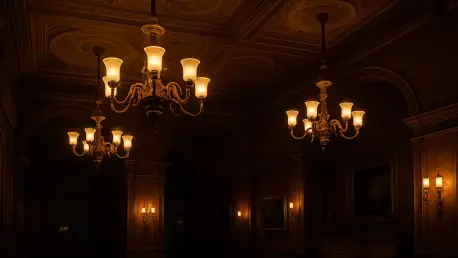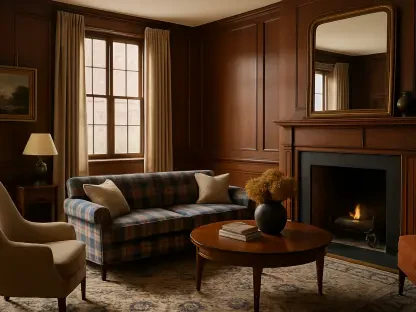In a world where interior design increasingly craves pieces that tell a story and stand out from mass-produced uniformity, a remarkable collaboration between Pooky Lighting, a dynamic British brand celebrated for its daring and whimsical approach, and GP&J Baker, a storied textile house established in 1884, has emerged as a beacon of inspiration. Their joint venture, known as the Archive Discoveries Collection, masterfully resurrects forgotten patterns from a 140-year-old archive, breathing new life into them through a contemporary lens. This partnership results in an exquisite array of lampshades and lighting accessories that seamlessly blend historical elegance with modern playfulness, captivating design aficionados and decorators seeking to infuse spaces with personality and depth. Far from being a mere nostalgic exercise, this collection reimagines the past to resonate with today’s aesthetic sensibilities, proving that heritage can indeed thrive in modern homes.
The synergy between these two brands is rooted in a mutual dedication to craftsmanship and innovation. By delving into GP&J Baker’s vast repository of textile designs, many of which have remained untouched for decades, the collaboration transforms historical motifs into functional art pieces. This endeavor not only honors the intricate patterns of yesteryear but also reinterprets them with vibrant hues and bold trims, ensuring relevance for contemporary interiors. From statement pendants to subtle cordless lamps, the collection offers something for every style, encouraging a fearless approach to mixing patterns and colors. This fusion of old and new speaks to a broader movement in design, where authenticity and storytelling are prized, positioning the Archive Discoveries Collection as a standout in a market hungry for unique, meaningful decor.
Celebrating Heritage Through Design
Unearthing Forgotten Treasures
The foundation of the Archive Discoveries Collection lies in a meticulous exploration of GP&J Baker’s extensive 140-year archive, a treasure trove of patterns that have often lain dormant for generations. This endeavor reveals designs that carry the weight of history, with some motifs dating back over a century, untouched by modern eyes until now. A prime example is the Bokhara Ikat, a striking pattern from the early 1900s, which stands as a testament to the enduring allure of historical craftsmanship. Reviving such designs is not merely an act of preservation but a deliberate effort to reconnect with the artistry of the past. These patterns, once confined to textiles of a bygone era, are now given a new purpose, allowing them to resonate with today’s design-conscious audience through carefully crafted lighting accessories.
Beyond individual patterns, the process of unearthing these forgotten gems reflects a profound respect for the legacy of textile design. Each motif selected for the collection tells a story of cultural and artistic significance, capturing moments in time that might otherwise fade into obscurity. The painstaking curation ensures that only the most evocative designs are brought forward, blending historical authenticity with a renewed sense of relevance. This approach highlights how archival exploration can serve as a bridge between eras, offering inspiration that feels both timeless and timely. The result is a collection that not only celebrates the past but also invites modern decorators to weave these storied designs into the fabric of their own spaces.
Honoring Historical Aesthetics
Drawing from the rich tapestry of 19th-century influences, the collection pays homage to Central Asian textiles and organic forms that defined design sensibilities of that era. Patterns like Zaraband, inspired by intricate smocks from the region, evoke a sense of wanderlust and cultural depth, grounding the collection in a historical narrative that speaks to global craftsmanship. These designs are more than mere aesthetics; they embody the stories of artisans and the societies that shaped them, preserving a legacy through each carefully chosen motif. Such reverence for historical aesthetics ensures that the collection carries an authenticity that resonates deeply with those who value heritage in their decor choices.
Additionally, the storytelling embedded in these patterns adds a layer of emotional connection for those who encounter them. The fascination with nature, a prominent theme in 19th-century design, is evident in motifs that mimic the organic beauty of the natural world, connecting past obsessions with present-day appreciation. This continuity of interest underscores the timelessness of certain design elements, proving their adaptability across centuries. By integrating these historical aesthetics into modern lighting, the collaboration creates a dialogue between eras, allowing decorators to infuse spaces with a sense of history while maintaining a fresh, relevant look that aligns with contemporary tastes.
Blending Old and New
Modern Sensibility Meets Classic Craft
A defining feature of this collaboration is Pooky Lighting’s innovative approach to revitalizing archival patterns with a modern twist, achieved through the bold application of color and distinctive trims. Traditional designs, once bound by the muted palettes of their original contexts, are reimagined with vibrant hues that breathe fresh energy into each piece. This infusion of contemporary flair transforms classic motifs into statement decor that feels at home in today’s eclectic interiors. The seamless marriage of old-world craftsmanship with new-world aesthetics showcases a deliberate intent to honor history while pushing the boundaries of conventional design, creating a collection that defies temporal constraints.
Voices from both brands underscore the excitement of this creative fusion. Ann Grafton, Managing and Creative Director at GP&J Baker, highlights the thrill of seeing archival designs reborn with a modern sensibility, emphasizing the potential for these patterns to captivate a new generation. Similarly, Jo Plant, Chief Creative Officer at Pooky, speaks to the joy of uncovering hidden treasures from the archive and infusing them with a spirited, color-forward perspective. Their shared vision reveals a commitment to bridging the gap between past and present, ensuring that each piece in the collection carries both historical weight and contemporary charm. This balance results in lighting accessories that are as much a celebration of innovation as they are a nod to tradition.
Artistic Reinterpretation
The transformation of traditional textile patterns into contemporary lampshades represents a form of artistic reinterpretation that elevates the collection beyond mere decor. Take the Bokhara Ikat, for instance, which, when rendered on 100% linen drum shades, takes on a painterly quality reminiscent of a watercolor masterpiece. This shift from fabric to lighting medium redefines the pattern’s purpose, turning it into a focal point that commands attention in any room. Such reinterpretation is a testament to the creative vision driving the collaboration, where historical designs are not just preserved but reimagined as functional art pieces that speak to modern design lovers seeking unique expressions of style.
Moreover, this artistic approach ensures that nostalgia is balanced with a cutting-edge sensibility, appealing to a wide range of aesthetic preferences. The collection’s ability to straddle the line between reverence for the past and enthusiasm for the present lies in its thoughtful execution of each design. Patterns that once adorned textiles of a bygone era now illuminate spaces with a renewed sense of purpose, blending seamlessly into both minimalist and maximalist settings. This duality of function and form underscores the innovative spirit of the partnership, offering decorators the chance to explore historical motifs through a distinctly modern perspective that feels fresh and exciting.
Versatility in Interior Design
Mix-and-Match Styling
One of the standout qualities of the Archive Discoveries Collection is its emphasis on versatility through mix-and-match styling, inviting decorators to experiment with pattern and color in dynamic ways. Shades like Bokhara Ikat are crafted to anchor a space with their bold, grounding presence, while Tuffley prints introduce a playful contrast that enlivens the room. This intentional design strategy encourages a layered approach to decor, where multiple patterns can coexist harmoniously without overwhelming the eye. The collection aligns with Pooky’s maximalist ethos, championing the idea that more can indeed be more when done with thoughtful curation, resulting in spaces that feel vibrant and deeply personal.
This flexibility in styling also empowers individuals to break free from conventional design constraints, fostering creativity in how spaces are composed. By designing shades to complement one another, the collection removes the fear of clashing patterns, instead promoting a sense of adventure in combining different elements. Whether it’s pairing a statement pendant with a subtle cordless lamp or mixing bold trims with understated bases, the possibilities for customization are vast. This approach not only enhances the visual appeal of a room but also allows for a tailored expression of style, ensuring that each piece contributes to a cohesive yet eclectic narrative within the home.
Adapting to Diverse Spaces
The adaptability of the collection to a variety of interior aesthetics further cements its appeal, catering to spaces that range from breezy and neutral to richly jewel-toned. Whether incorporated into a minimalist living room or a boldly decorated bedroom, these lighting accessories offer a chameleon-like quality that adjusts to the surrounding decor. This versatility ensures that the historical patterns resonate across different design sensibilities, making them suitable for a wide audience. Styling suggestions, such as pairing shades with aged brass finishes or sculptural bases, provide practical guidance for achieving unique looks that enhance the character of any room.
Beyond aesthetic adaptability, the collection’s pieces are designed to serve multiple functional roles, from statement-making centerpieces to subtle accents that tie a space together. A Bokhara Ikat shade might dominate as a pendant over a dining table, while a Tuffley print could softly illuminate a bedside nook with understated charm. Such diversity in application speaks to the thoughtful design behind each item, ensuring that they meet the practical needs of modern living while maintaining their historical allure. This ability to fit seamlessly into varied environments highlights the collection’s strength in offering decor solutions that are as functional as they are beautiful.
Reflecting Broader Design Trends
Resurgence of Vintage and Eclecticism
The Archive Discoveries Collection taps into a significant trend within interior design: the resurgence of vintage-inspired decor paired with modern eclecticism. As consumers increasingly seek out pieces that carry a sense of history and individuality, this collaboration answers the call by reviving heritage patterns with a contemporary twist. The demand for authenticity over mass-produced items has fueled a movement toward curated spaces that reflect personal narratives, and these lighting accessories deliver precisely that. By merging the charm of yesteryear with today’s bold design language, the collection positions itself at the forefront of a shift toward meaningful, story-driven decor.
This trend also reflects a broader cultural appreciation for blending disparate elements to create cohesive yet dynamic interiors. The ability of historical motifs to coexist with modern styling speaks to a growing comfort with eclecticism, where the old and new are no longer seen as opposing forces but as complementary partners. The collection’s success in capturing this balance suggests a lasting impact on how decorators approach heritage elements, encouraging a fearless integration of vintage aesthetics into contemporary settings. This resurgence signals a deeper desire for connection to the past, reimagined through a lens that celebrates individuality and creativity in home design.
Timeless Appeal of Organic Forms
Another design trend mirrored in the collection is the enduring fascination with organic forms, evident in patterns like Tuffley, which features meandering, seaweed-like motifs reminiscent of 19th-century nature-inspired designs. This connection to the natural world, a recurring theme across centuries, remains strikingly relevant in today’s interiors, where organic shapes and textures are often used to bring warmth and grounding to spaces. By incorporating such patterns, the collection not only nods to historical design preoccupations but also aligns with current preferences for decor that evokes a sense of calm and connection to the environment.
The timeless appeal of these organic motifs lies in their ability to transcend specific eras, offering a visual language that feels both familiar and fresh. Their integration into lighting accessories adds a layer of sophistication to the collection, allowing decorators to introduce natural elements into their spaces in subtle yet impactful ways. This alignment with ongoing design inclinations underscores the collection’s relevance, proving that certain aesthetic principles, like the allure of nature, hold universal and enduring charm. As such, the collection serves as a bridge between historical fascination and modern-day appreciation, enriching interiors with a sense of continuity and harmony.
Crafting Timeless Spaces
Reflecting on the journey of the Archive Discoveries Collection, it’s clear that the partnership between Pooky Lighting and GP&J Baker carved a unique path in the design world by reviving 140-year-old patterns with unparalleled creativity. Their efforts resulted in lampshades and lighting accessories that stood as both functional decor and artistic tributes to history. This collaboration honored the intricate craftsmanship of Bokhara Ikat and Tuffley prints, weaving stories of the past into the fabric of modern homes. It mirrored a pivotal shift in interior trends, where authenticity and personal curation took center stage, leaving a lasting imprint on how heritage was perceived in design. Moving forward, the industry can draw inspiration from this endeavor by exploring archival resources to create pieces that resonate with today’s audiences. Designers and decorators are encouraged to experiment with blending historical elements into contemporary spaces, using this collection as a blueprint for crafting environments that tell compelling stories while embracing innovation.









